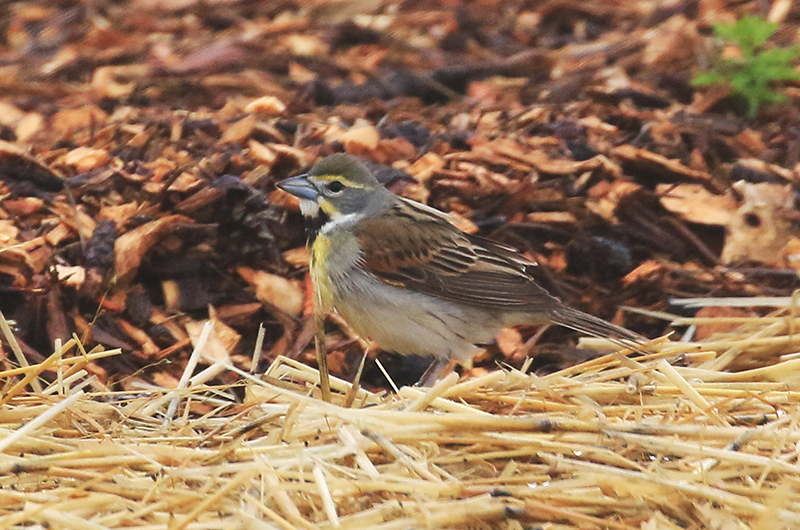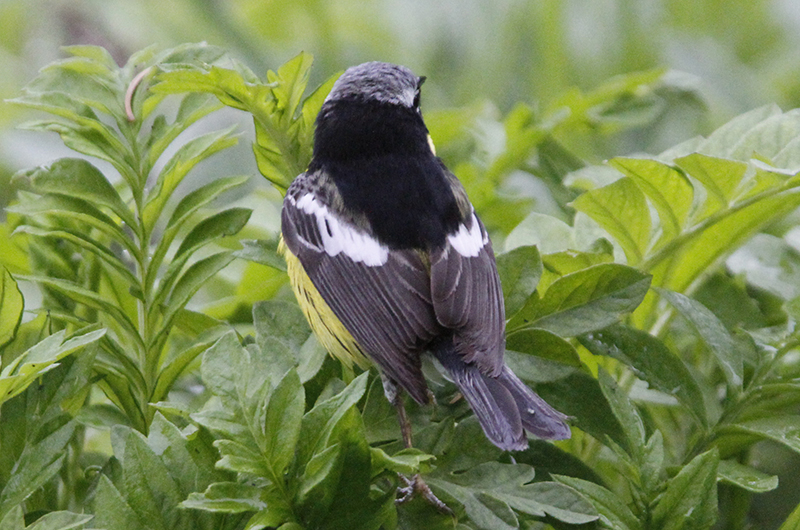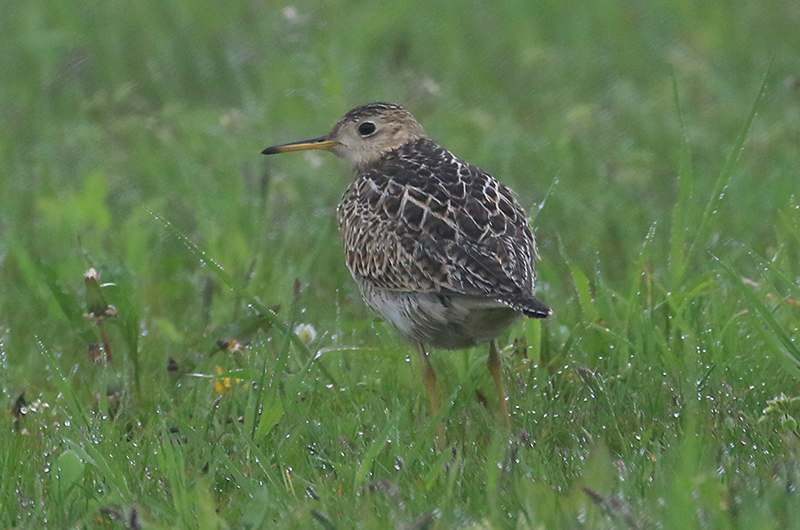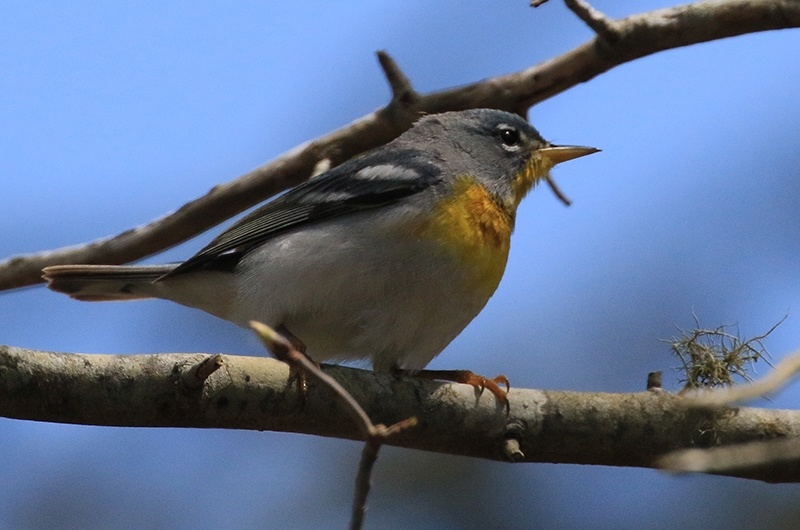Spring migrations used to be more exciting, with lots of colorful warblers pouring through especially at a hotspot like the Oak Bluffs Pumping Station (also known as the Head of the Lagoon). After looking at the weather patterns showing southwest winds beginning on the evening of May 19, and radar maps showing clouds racing up the Atlantic Coast, I had a feeling that Sunday might be the day.
On May 20, I visited the Pumping Station and migratory birds were plentiful, just like my hazy memories from the late 1970s and early 1980s. I ended up staying there for almost two hours and found 42 species.
Most notably, I found 11 species of warblers. The first migrants I saw, only about 100 feet down the road, were in a partially leafed out maple: a magnolia and a Cape May warbler. Then for a while I only heard and saw lots of yellow warblers, a common breeding species. Then came the onslaught: ovenbird, northern waterthrush, black-and-white, common yellowthroat, American redstart, chestnut-sided, prairie and black-throated green. Other highlights include red-eyed vireos, northern rough-winged swallows, wood thrush, belted kingfisher, and a whole bunch of our common resident species. Six recently hatched goslings were bunched up with two Canada geese, and nine recently hatched cygnets were with a pair of mute swans.
The same day, Scott Stephens spotted a pair of bay-breasted warblers in the Phillips Preserve.
The migration continued that night (songbirds are nocturnal migrants) with more favorable weather, as Matt Pelikan noted the influx by spotting chestnut-sided warbler, yellow warbler, common yellow-throat and northern parula near his Oak Bluffs house on May 21. And at lunchtime Ken Magnuson found blackburnian, blackpoll, bay-breasted and black-throated green warblers at the Edgartown Golf Club.
On May 21, Allan Keith visited Squibnocket and found species that breed in the northern spruce forests including blackpoll, bay-breasted, Tennessee, and yellow-rumped warblers and blue-headed vireo, as well as resident species red-eyed vireo, redstart, black-and-white warbler, yellow warbler and yellowthroat.
This is migration as we like it.
Bird Sightings
On May 20, Ken Magnuson found an upland sandpiper at the Farm Institute. He notified others and Susan Whiting, Pat Hughes and Luanne Johnson were able to see it. This is the second sighting of the spring. The first “uppie” was found on April 28. As can happen when multiple birders descend on a particular location, another unusual species was found, as Susan and Pat found a male dickcissel in the garden plots near the Headquarters of the Farm Institute. We are much more likely to see both these species in the fall. Margaret Curtin found the dickcissel and the bobolink that afternoon.
I spotted a red knot — a species of sandpiper — on Norton Point on May 19. It was in full breeding plumage so its salmon-orange–red undersides were conspicuous even through my spotting scope from the Edgartown Bay Road boat launch ramp. Other shorebirds were seen, mostly in breeding plumage, included black-bellied plovers, dunlin, sanderling, ruddy turnstone and the drabber residents willets and piping plovers.
On May 21, Allan Keith added a roseate tern on Norton Point, and both bobolink and eastern kingbird in Katama.
Ken Magnuson also found a few migrant warblers on May 19 at Lambert’s Cove, including bay-breasted warbler, black-throated green warbler, and blackpoll (also a warbler even though such is not in its name). That afternoon Kelly Magnuson joined him and they found a bobolink in the fields of the Farm Institute.
The 116th species Gus Ben David observed in his yard was a brown thrasher on May 21. There used to be a few pairs nesting at nearby Felix Neck (no more), but this is the first time he has seen one in his yard in the 26 years he has lived there. He comments that more than 30 Baltimore orioles are visiting his yard, feasting on the fruit jelly he puts out. And the nesting screech owls have youngsters big enough to stick their heads up to the entrance hole to peak out at the outside world.
John Nelson spotted lots of common terns fishing in Nantucket Sound just outside the Harthaven breakwaters on May 20.
Cedar waxwings have greeted Connie Alexander on the mornings of May 20 and 21. The waxwings have been flitting around in her oak trees.
On May 18, Susan Whiting spotted both white-crowned and the much more common white-throated sparrows visiting her Quenames feeder. She has also had a pair of rose-breasted grosbeaks visiting her feeders for the past week.
Barbara Lott found a late red-breasted merganser on Caleb’s Pond.
The black skimmers are ever-popular. Ten of them were spotted at Little Beach on May 20.
On the breeding species reports, Rick Karney found a Carolina wren nest in one of his nest boxes on May 18, and a cardinal nest on May 16. Laurie Otis also found a cardinal nest with at least four one-day old chicks.
One final note: I have never before seen a flock of 43 American goldfinches, but that is how many there were between the parking lot and the cattle pasture at the Farm Institute. They were flying back and forth between the wire fencing and the ground, where they were feeding on the overly abundant dandelion seeds. The yellow of the males was a close match to the yellow dandelion flowers.
Spring migration is at its peak! Please report your sightings to birds@mvgazette.com.
Robert Culbert leads Saturday morning Guided Birding Tours (starting Memorial weekend) and is an ecological consultant living in Vineyard Haven.












Comments
Comment policy »